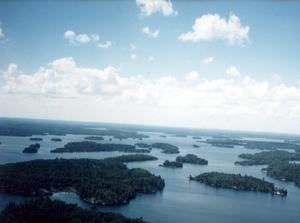

| When Canada became involved in the Second World War no aspect of domestic life was unaffected by the conflict beyond her border. In 1943 new tangible evidence of the war appeared on the shores of Lake of the Woods. The German Armed Forces had arrived. They descended on the lake, not as invaders, but as prisoners of war as part of a government effort to alleviate the chronic pulp and fuel wood shortages experienced at that time. |
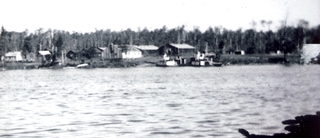
Camp 52, POW Bay, Lake of the Woods |
The following history of the prisoner of war work camps in the Lake of the Woods area examines the administrative and operational framework in which pulp and fuel wood were secured by the federal government and the Ontario-Minnesota Pulp and Paper Company, (O&M) through the labours of the German prisoners of war (POW). In addition, this discussion illustrates that by participating in the prisoner of war work project, the Lake of the Woods area played a small but important role in providing the necessary resources which assisted Canada's war effort. The service rendered by German prisoners of war in logging camps around Lake of the Woods must be presented within the context of three inter-related factors: Canada's internment operations, her natural resource requirements, and her war commitments.
As late as September 1939, Canada was very reluctant to be involved in another world war as she was ill-equipped and generally unprepared to fight. Germany's successful invasion of Poland on September 1, 1939 prompted Poland's allies, Britain and France, to enter the war in her support. This forced Canada's hand. On September 10, 1939 after a vote in the Canadian Parliament, Canada joined Britain in her war with Germany. Militarily Canada was poorly prepared for war. Little was done to better equip the country's Armed Forces for a combat role. Ensuring domestic security, however, received consideration by the Canadian Defence Committee (CDC), a government body headed by Ian Mackenzie, the Minister of Defence. The Committee's report which led to the Defence of Canada Regulations provided policy guidelines for an internment operation which targeted those likely to assist the enemy within Canada.
Once war was declared the federal government proceeded under the authority of the Defence of Canada Regulations and the War Measures Act to intern in Canada anyone who was an enemy alien or suspected subversive, as well as any persons whose ethnic origins were from a country in the German Alliance. The Department of National Defence (DND) and the Department of Secretary of State were the principal administrative and logistical shareholders; while the RCMP provided the leg work in the arrest and detention process. The two Departments established an Internment Operations Directorate on September 4, 1939. The first Director was Major-General Edouard de Panet, a staff officer of the First Canadian Division during WWI. His Assistant-Director was Lieutenant-Colonel Hubert Stethem. Stethem was a career officer with First World War experience as well. Both were dedicated and capable men.
These qualities were immediately tested. The Internment Operations unit was charged with the task of finding the proper facilities to house, feed, and provide essential services for interned civilians as well as captured soldiers. The unit was, from the outset, racing against time. As both men scrambled to acquire office furniture the RCMP were arresting and detaining suspected subversives. Most of the first internees were Germans, German Canadians, Canadian Fascists, Italian Canadians, members of the Canadian Communist Party, and unionists. By summer 1940, 1200 people were detained. By the end of September two large camps were opened, one located in Petawawa, Ontario and the other in Kananaskis, Alberta. In the following months other converted buildings and jails served as internment centres for the POW's and interned civilians from Britain. By 1942 nearly all detainees except captured German military personnel had been released from the restriction imposed on them in 1939.
While Canada rounded up suspected saboteurs, the war in Europe was not going well for the Allies. Britain seemed shocked by Germany's battlefield successes which quickly overran Denmark, Norway, Holland and Belgium in the spring 1940. By early June France was also incapacitated and a trapped British Army was forced into a hasty retreat from Dunkirk; practically all of Western Europe belonged to Hitler leaving only Britain unconquered. British authorities took action against persons who were suspected Nazi collaborators in England. With the enemy so close at hand and fearing an eminent invasion, the British asked Canada to accept enemy aliens and the German POW's it had captured. Realizing the urgency of Britain's' plight, Prime Minister Mackenzie King's Government agreed to accept their suspected civilian and German POW's. The first ships set sail for Canada on June 20. By the end of July 1940 approximately 4,000 British internees and 3,000 German prisoners had debarked at Canadian ports. Over the course of the ensuing months, Dominion and British authorities formalized the arrangements in which prisoners of war would be held. Both countries agreed that Britain would pay for the costs of transporting and maintaining the POW's which included camp construction and meals. Canada would pay for work projects, camp hospitals, guard salaries and work performed by interned personnel.
Throughout the fall and early winter 1940-41 Canadian authorities prepared for the arrival of more POW's. A continuous flow arrived in Canada from 1941 to 1944. The first group of 3,989 battle hardened German soldiers arrived in January 1941. As the Allied Forces became more successful on the battlefront their results, in part,
could be measured by the increased numbers of captured German soldiers. By the end of 1942 Canada played housekeeper to approximately 20,000 additional German POW's. In 1943, 6,000 arrived and by the end of 1944 a further 10,000 German soldiers were interned across Canada. Over the course of those three years, (1941-44), twenty six facilities were built or renovated to accommodate the steady arrival of new prisoners. Most of the camps were located in Ontario, Quebec and Alberta. Two of the largest camps were Lethbridge, opened in November 1942, and Medicine Hat which was opened in May 1943. Both centres held up to 12,500 captives. Other large camps in Ontario usually held anywhere from 300 to 650 POW's. As will be discussed many of the bushworkers in Lake of the Woods came from either an Alberta camp or an Ontario camp such as Monteith.
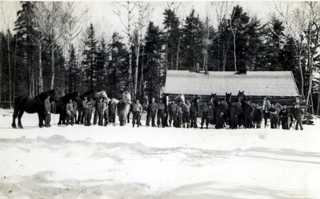
Prisoner of War Work Crew with Horses |
During the early years of the war, 1940-41 the number of prisoners in Canada were modest but thousands were anticipated, and the associated responsibilities of quartering and security led the government to consolidate the administration of the POW program within one Department. In November 1942, the Federal Cabinet signed Privy Council Order 10571 which severed the joint DND/Department of Secretary of State arrangement and allocated complete authority for POW operations to DND. In January 1943, DND recruited new personnel and appointed Colonel HN Streight as Director of POW operations. As noted, by the end of 1942 there were approximately 20,000 POW's in Canada. By 1945 that number would swell to approximately 38,000. The demands of the battlefront quickly absorbed the military personnel who had been assigned guard duty. Fortunately, DND had planned for this eventuality and instituted a policy to meet the guard requirements. |
As early as May 1940, the Department had created a new organization called the Veteran Guards of Canada. They assumed responsibility for guarding the captured soldiers in May 1941. The Veteran Guards consisted mostly of First World War veterans too old for battlefront duty. The maximum age for duty was fifty, but many slipped in despite their age. Veteran Guard units were formed across Canada and they were assigned several different tasks ranging from guarding military targets, dams, bridges, power plants to government installations. The most important assignment, however, was guarding POW's. From an initial limited recruitment of a few hundred men, the Veteran Guards of Canada expanded to over 10,000 by 1943 and was 15,000 strong by 1945. At first glance, the aging First World War veteran seemed an unlikely candidate for guarding extremely well trained battle hardened enemy soldiers. Yet the guards possessed experience, and many had been POW's themselves in WWI. They understood the prisoner mentality and the regimen of a controlled life. The Veteran Guards were used extensively in all parts of Canada including the bush camps located on Lake of the Woods.
The circumstances which led to the placement of POW's and their guards in Lake of the Woods stemmed from a combination of scarce manpower in the forestry industry and an increased demand for wood fuel, pulpwood and lumber. Canada's call to arms led a large numbers of men to enlist in the country's Armed Forces. As the war progressed, men continued to enlist, or found work in essential war industries in Canada's major centres. In smaller centres population decreases strained local economies. In Kenora, for example, the population dropped by about 1,460 people as many no doubt enlisted or worked in other war industries. The lower paying bush jobs, and for many men, the bush camp's living environment made logging unattractive.
By 1942-43 the usual number of seasonal bushworkers had declined, and production had faltered at a time when demand for lumber, pulpwood and wood fuel increased. The production of pulpwood during the 1942-43 operating season was one million cords below the previous year. Wood fuel followed a similar trend with 1.3 million cords below normal output levels; which was accentuated by a severely cold 1942-43 winter season. Debates in the House of Commons reflected this crisis. "Despite appeals made last year for an increased production of cordwood, insufficient was cut to last out the winter and some sections of the country already have suffered... Canada faces a wood fuel famine so serious that unless immediate action is taken many thousands may be unable to heat their houses adequately next winter." In a bid to rectify the problem the Government passed P.C.1752 on March 5, 1943. The Order provided the Department of Munitions and Supply the legal authority to appoint a Coal Controller and a Deputy Wood Fuel Controller. Their task was to coordinate an effective wood fuel use and supply strategy with the Wartime Price and Trade Board.
Strategic planning and policy coordination were only half of the equation. Production had to be increased and manpower was the only solution. The Department of Labour and the National Selective Service tried to meet the industry's labour needs, but the strains of war were beginning to show and new labour sources needed to be tapped. The federal government reluctantly decided to avail itself of the interned POW's. By 1943, over 25,000 German prisoners were held in Canada. On May 10, 1943 the King Government put in place new regulations which gave the Department of Labour and DND the authority to employ prisoners on work projects to help alleviate the labour shortages in the agricultural and natural resource sectors. The regulation clearly stated that only those POW's who volunteered to work would be used and that the work done by the POW's "shall have no direct connection with the operation of the war. In particular it is forbidden to employ prisoners in the manufacturing or transportation of arms or munitions of any kind or any transport of materials destined for combat units." A few weeks later on June 2, 1943, the Department of Labour set up a Directorate of Labour Projects and appointed Lieutenant-Colonel RSW Fordham as its first Director.
The primary purpose of the new Directorate was to allocate POW labour to primary industries needing workers. The Directorate was responsible also for ensuring the work camps met Geneva Convention guidelines. To administer the work projects, the Department of Labour and DND cooperated within their respective jurisdictions. DND was responsible for security, discipline and supplying guards, (Veteran Guards). The Minister of Labour was responsible for providing employment arrangements, accommodations, and supplies for the welfare of the prisoners outside the internment camps. The Department established guidelines to accommodate the prisoners, set wage scales and collected monies owing to the government for the labour services of the internees. Businesses wanting to employ POW's had to first apply to the Department.
Contracts between government and private lumber companies such as Ontario-Minnesota Pulp and Paper and JA Mathieu provided a fairly comprehensive framework for employment based on the articles of the Geneva Convention. For example, transportation to and from work was to be provided by the employer. Marching to the bush camp was permitted as long as the walk was not excessive. Clothing, boots and tools for bushwork was provided by O&M Medical attention and compensation for accidents was stipulated by article 27 of the Geneva Convention. Hospital
care was rendered in a civilian hospital if a military facility was unavailable.
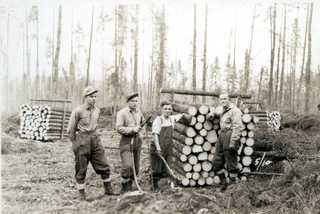
Prisoners of War Stacking Cords of Wood |
The quota system of work for POW labour appeared to be used extensively in pulpwood production. Simply stated, once the assigned amount of wood to be cut was reached the cutter was at his leisure. In most pulpwood agreements the daily cut limit was 3/4 of a cord per day. One day a week was granted a rest day, usually Sunday. The pay rate for POW work was standardized at 50 cents per day. Prisoners were credited earnings and used the credit to purchase items from the company store. Items the prisoners could purchase were restricted to food or ordinary articles which were not tightly rationed. |
Most of the camps seemed to contain between 100-125 workers, and the living quarters provided by the company appeared to be the same if not better than those conditions found in similar bush camps of the day. Under the terms of the Geneva Convention, the Department of Labour was responsible for ensuring that proper living conditions were supplied by the contracting employer. A pure water supply and adequate sanitary arrangements were especially important. The company was required to feed the POW's on a ration scale equal to what Canadian Army personnel held in depot would receive. The cost of feeding the workers was deducted by the company from the amount owed to the government for hiring the POW's.
The relative solitude of the camps did not allow the Department of Labour or the businesses hiring POW labour to stray from the regulations and International rules. It appears that inspections were conducted by Department officials and the Swiss Consulate which acted as the German Protecting Power in Canada. Finally, the POW's themselves through letters of compliant to the Swiss Consulate would have alerted the proper authorities of any serious problems within the camps.
Responsibility for security of the bush camps, it appears, was delegated to the employer. The company was technically responsible for ensuring "to the best of its ability," that the POW's did not venture from the company's land, fraternize with locals or other civilians such as tourists. DND, however, was responsible for supplying guards and making the necessary on site security arrangements.
As the chronic labour shortage continued, the area's largest pulp and paper company, Ontario-Minnesota Pulp and Paper, applied for and received approval to use German prisoner labour in their cutting operations in the Lake of the Woods area. In spite of an apparent labour shortage not everyone was ready or willing to accept German prisoners in their locality. Public opinion polls seemed to reveal a close split in attitudes. Respondents to a spring 1943 Gallup Poll indicated, when asked if POW's should be used in essential war work in groups under armed guard, that 42% approved and 46% disapproved, while 12% were undecided. The division in public opinion should come as no surprise. Since 1939 the news media and Canadian authorities had taught the public to fear and hate Nazism. The thought of allowing the Nazi menace into the neighbourhood was too much for some citizens to accept.
Unions were critical also of the plan to use German labour in the bush. Labour leaders believed this was another corporate tactic to keep wages low, take jobs away from union members, delay improvements to bush camp living conditions, and ultimately break the union. Finally, union leaders were skeptical that interned workers would make a significant contribution to the total amount of pulpwood cut during the work season.
Despite these objections, in late fall of 1943, under the supervision of the Veteran Guards of Canada, trains carrying POW's began arriving in Kenora. Many prisoners like Hans Lieberwirth arrived from Medicine Hat or Lethbridge, the two largest detention centres, while others such as Hans Kaiser came from internment camps like the one at Monteith, near Timmins, Ontario. The train ride to the lake area was about twenty-four hours and all the train windows were blocked out to prevent the prisoners from determining their location. They were escorted by two to four guards per passenger car. The first POW's arrived in Kenora in September and October. The train deposited all one hundred and fifteen prisoners at a point near the lake where they were promptly marched by the ten to twelve accompanying Veteran Guards to a waiting barge to take them to their bush camps. Mr Kaiser recollects that the journey to their camp took four to five hours as it wound its way around the many islands and channels of the lake. When POW's arrived during the winter months they were trucked from Kenora, and then marched if necessary, over the ice to their respective facilities. Mr. Lieberwirth recalled that they were trucked to Witch Bay Camp and then walked to the camp. The walk lasted approximately two hours.
The Ontario-Minnesota Pulp and Paper Company (O&M) built six camps in the Lake of the Woods area. Five camps were nestled throughout the bays and islands of Lake of the Woods. Two camps were situated on the Aulneau Peninsula. Camp 56 (Alfred Inlet), and camp 57 (Ghost Bay). Camp 61 was situated at Oak Point on the western peninsula. Camp 52 was at Red Cliff Bay (now POW Bay); and Camp 43 was on Adams River near Yellow Girl. The last work centre, Camp 60, was on Berry Lake. Each of the camps contained between 100-125 men and the POW's were a mix of navy, air and army personnel with a few from the German merchant marine.
| The layout of the camps did not seem to vary among the six camps. Descriptions provided by Mr. Lieberwirth who resided at camp 52 and Mr. Kaiser who lived at camp 61 indicated that the settlement was satisfactory and consisted of 3-4 living quarters, a dining cabin and kitchen, a boss and canteen cabin, an entertainment cabin, a Veteran Guard cabin, a first aid building, outhouses, an equipment building\blacksmith shop, and stables. |
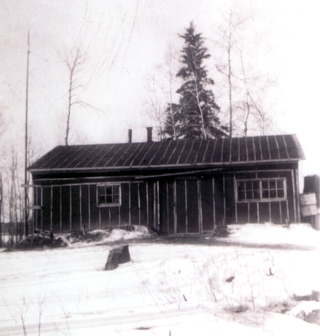
Camp Boss Cabin |
In addition, the Ontario-Minnesota Pulp and Paper Company maintained a camp foreman, a crew boss to inspect the cutting, a camp clerk, cook, assistant cook, mechanic/blacksmith, general handy-man, and a "walking boss" or area supervisor. The supervisor was responsible for and inspected the camps in the area. As well, a facility for a visiting doctor was built at each camp. Seriously injured workers were taken to the hospital in Kenora. Finally, four to six Veteran Guards were stationed at each camp.
According to Mr. Lieberwirth their living quarters were generally 24x40, constructed of rough 1x6 overlapped boards for the walls, (no insulation) and rough 1x6 boards for the roof with black felt roofing paper on the roof and sides. There were two windows on the front and back of each building. The cabin floors were generally made of 2x12's
and the building was heated by a large drum stove located in the middle of the cabin. The camp had no barbed wire and there was little or no contact between the camps on the lake. The POW's knew that other bush camps existed, but did not know the locations or have the means to travel. Whatever was known about another camp was usually by word of mouth from an O&M employee or visitor. It appeared that the authorities believed the relative isolation and rugged terrain would provide a natural enclosure.
| Diagram Legend
1. Entertainment Cabin
|
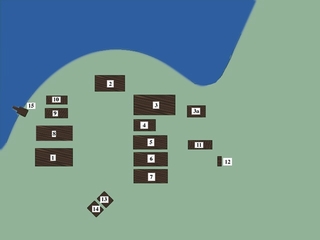 |
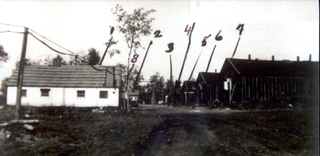 |
The camp command structure was a coalescence of three inter-related bodies. The guards counted heads, hunted and fished and handled any problems that arose with respect to wild animals. The O&M personnel ran the camp and the wood cutting operations. The prisoners elected their camp leader and ensured group discipline amongst themselves. The POW's often used skills from their civilian background to assist the camp cook and other company workers with their work duties in a bid to add variety to the camp routine. |
Once settled in their new surroundings, camp officials wasted little time assigning work schedules to the crews. Armed with an axe, swede saw, and an eight foot measuring stick, POW's were sent into the bush to cut their daily quota of wood. Officially each prisoner was to cut 3/4 of a cord of wood. In practice this amount seemed to have varied depending on the camp. Hans Lieberwirth working at camp 52 noted that they were required to cut one cord per day. At camp 60, however, Hans Kaiser stated that they were told to work for eight hours or cut one cord which ever came first, while Hans Seefeld remembers being told to cut 1/2 cord per day. In most camps their primary task was to cut pulpwood, and fuel wood and to build roads to haul the wood out in the spring. If their location was close enough to the lake cutting the road right of way was less time consuming. The logging techniques employed by the prisoners were the same as those practiced by bushworkers of the period. After a few days of training in how to use an axe and swede saw as well as drive the horses, the POW's were able to meet their daily quota. As the trees were sawed and branches removed they were cut into eight foot lengths, stacked and loaded to be hauled by horse and sleigh to the ice in the bay. In late spring/early summer the logs were assembled into booms and towed to the mill in Kenora.
Despite the discrepancies in work quotas, the daily routine of the prisoners seemed to be fairly consistent within the six camps. The day started at 6:00 a.m. with roll call, breakfast and daily preparation. Breakfast usually consisted of fried eggs and bacon, milk, coffee, sugar, cornflakes, butter, fresh baked bread, maple syrup, jam, and marmalade; pancakes and sausages were served as an alternate to eggs and bacon. The work day began at 7:00 a.m. Most cases the workers carried a lunch to the job site. Lunches were carried in lunchboxes and consisted of two large sandwiches, sausage and bacon, pie, one apple and tea. The dinner meal was no exception for the abundance of food. Mutton, spare ribs, beef, potatoes, vegetables, dried plums, cookies and cake for dessert were the norm. All food was brought in by boat every two weeks in the summer. During the winter it was delivered by truck or sleigh once a month and food supplies were stockpiled in an ice house to ensure a supply during spring thaw and fall freeze up.
| When the prisoners had cut their quota, usually by early afternoon, the rest of the day was spent on leisure activities. The range of leisure options seemed impressive. Soccer, hiking, and swimming. Building dug out canoes and kayaks and racing them passed many summer hours. |
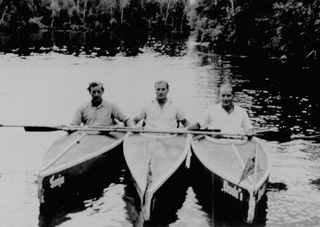 |
The prisoners were allowed on fishing trips in the immediate vicinity of the camp. On these excursions it was not uncommon to meet US tourists and sell them handicrafts which they made over the winter. In the evenings, books, movies, cards, board games, music either played or from a gramophone, and letters from home or news from an illegal radio helped relieve boredom and loneliness. In the winter months ice soccer and ice fishing were enjoyed, as were hobbies such as wood carving and painting. Mail was delivered through an O&M representative, when the dentist or doctor made their rounds, or when a member of the Swiss Consulate visited the camps, usually once a year. If the prisoners wanted anything extra they appeared to have had the opportunity to purchase the items from the camp "van" or canteen. Since the POW's did not receive money as payment for their labour, they were issued token credit equivalent to their fifty cents per day earnings. The usual purchases included: cigarettes, chocolate bars, fishing gear, or orders of dry goods from the Eaton's catalogue.
Rapport among POW's, the O&M employees and guards was generally amicable. If an issue arose the POW camp leader would present the problem to the O&M supervisor and the guards for a resolution. Both Hans Kaiser and Hans Lieberwirth recall the guards to be "easy going and very friendly." This non-aggressive attitude displayed by the captives combined with the reality that the soldiers were "out of the war" and in the bush with few options for escape likely contributed to the docility of camp life. Mr. Kaiser also noted that the men he was with were not ardent Nazis or strong supporters of the Hitler regime. However, they retained their soldier identity and maintained internal discipline. Given the circumstances they were satisfied with their situation.
For the most part security did not appear to be an issue for the prisoners or for the authorities. In most cases there seemed to be a general rule that the German prisoners were free to roam as long as they stayed within a one mile radius of the camp! Drinking with camp officials and the guards was not unheard of, and illegal distilleries within POW cabins hidden underneath floor boards were known to exist. Friendly relations were also extended to other activities. Hans Luengen, interned at camp 61, remembers going duck hunting with the guards. The apparent trust between guards and prisoners was evident in a story retold by inmate Luengen when a POW had to go to the dentist in Kenora. "One time a guy had to go into Kenora to see the dentist. Two guards went with him and they got really drunk. The prisoner had to put their rifles on his shoulders and drag them back to the boat. He didn't try to escape. None of us spoke English and there was nowhere to go."
It remains uncertain if all POW's, given the opportunity, would have acted as the prisoner in Luengren's account. In November 1944, Wilhelm Bergter and Erwin Stoeckel left their bush camp on Adams River near Yellow Girl Bay. Unfortunately, the cold weather proved to be too much for the men and they froze to death during their departure. Their bodies were recovered by the Ontario Provincial Police (OPP) the following spring, and buried in Kenora. Speculation remains as to the men's true intentions when they left their camp. Some believe they were trying to escape. Others, like Hans Kaiser, question why the men would try to leave in November rather than spring or summer? Kaiser believes the men were out exploring, got lost and panicked; cold and fatigue set in and claimed their lives. If any POW's contemplated escape it appears no one acted on the impulse. Perhaps the combination of isolation, rugged terrain, combined with the relative freedom provided by their captors persuaded against an attempt to leave the camps.
By 1945, approximately 1,800 to 2,000 POW's were cutting wood in bush camps throughout Northwestern Ontario; somewhere between 600-700 were residing along the shores of Lake of the Woods and Berry Lake. It appears that the POW project met the needs of industry and government. In fact in the early months of 1946 companies in the Kenora-Rainy River riding were requesting that the POW's remain for another season as bush workers were in short supply. Despite the objections of unions there seemed to be no job loss or job displacement on account of POW bush labour. While it is unlikely that POW labour was as productive as civilian labour, the wood cut under the POW project seemed to supply the extra pulpwood and fuel wood necessary to keep the mill in Kenora operating without civilian layoffs.
Throughout the last half of 1945 and early 1946 German workers went back to there primary internment centres in Alberta and Ontario enroute for repatriation to Germany. By May 1946 the last of the bush camps were closed. From the available evidence, the men who laboured in the bush felt they were fairly treated and well fed. For many their captivity in Canada and the bush camps of Lake of the Woods offered a security and certainty not offered anywhere else; where their only real enemy were the swarms of mosquitoes and the natural elements in which they lived.